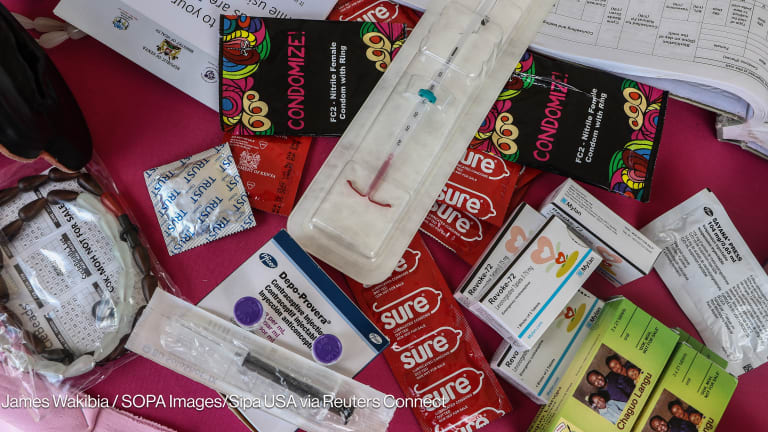
Reproductive health and decent work are inextricably linked for women. Across the globe, women are the primary caretakers of children and a woman’s reproductive years tend to overlap with her economically productive years. Planned and unplanned pregnancy and childbearing affect women’s ability to pursue different types of economic opportunities and even the choice of sectors in which they seek to work.
So why do programs that claim to promote women’s economic empowerment, or WEE, ignore this foundational barrier to their success?
Evidence citing the economic benefits of investing in comprehensive sexual and reproductive health and rights agenda are easily identified in the work and recommendations of development actors in the health sphere, yet limited reference and acknowledgment of SRHR exists in policy and programming on WEE.
More on women and the economy
► US announces first funding for women's economic empowerment initiative
► Women's economic empowerment gets a boost with passage of legislation
► Q&A: Kiva eyes impact investing after surpassing $1B in loans to women
For example, the U.N. High-Level Panel on Women’s Economic Empowerment only references SRHR once. Prominent WEE programs such as the Women Entrepreneurs Finance Initiative, the U.S. Women's Global Development and Prosperity Initiative, and Australia Advancing Women’s Economic Empowerment through Aid, Trade and Economic Diplomacy are remarkably silent on health care, social protection, and reproductive rights.
Women advance their sexual and reproductive rights when they have physical, legal, and economic access to health systems that provide essential services, such as contraceptives and family planning. Without access to these services, women struggle to stay healthy, participate in economic life and education, and enjoy lives that are not burdened by drudgery and time poverty.
Globally, female labor force participation decreases with each additional child by about 10-15 percentage points among women ages 25-39. It is not only the total level of fertility that affects labor supply but also the timing and spacing of births that allow women the freedom to choose when to learn and earn. Research also shows that improving reproductive health extends life expectancy for mothers and children, increases the incentive to invest in education, contributes to labor force participation and productivity, and leads to higher incomes and higher levels of asset accumulation.
Yet much of WEE programming often appears divorced from any analysis of health and reproductive health needs and rights.
WEE programming will often promote women’s financial inclusion, entrepreneurship or employment through training and skills building. Yet these initiatives often fail to recognize that employment or self-employment is a wholly inadequate goal without consideration of the quality, conditions, and type of work that women undertake.
Research by the Guttmacher Institute found that women’s early access to contraception is linked to higher post-secondary education and employment, increased earnings and a narrowing of the gender gap in pay. Guttmacher further found that teen pregnancy interferes with women’s ability to graduate from high school and that delaying a birth can reduce the “motherhood gap” or the pay gap between mothers and their childless peers.
When women cannot control the timing and spacing of their births, they face high care burdens. In efforts to balance these care burdens, women are often relegated to working in insecure, precarious and informal jobs due to the need for flexibility. The “choice” of formal and informal work is also likely to vary by women’s access to reproductive health services, their ability to carry out their fertility intentions, and better plan the timing and spacing of pregnancies and births, as well as their access to formal and informal care services.
In Thailand, researchers found that home-based workers cited the ability to combine paid care work and child care as a reason they engaged in home-based work; in Malaysia women who held low-skilled jobs said that they decided to start their own micro-businesses rather than return to formal work after having children; and in the Philippines, 20% of women in the informal sector cited family responsibilities as the reason they chose to engage in the informal sector as opposed to the formal sector.
For progress in WEE, we must invest in SRHR. This means that our approach to WEE policy and programs should be grounded in a reproductive justice framework with the goal of removing the systemic and structural barriers to their employment education and self-actualization that women, especially marginalized women, face.
Governments and donors can adopt this approach to WEE policy and programming priorities by investing in measures such as parental leave, child care, and elder care services, and universal access to reproductive health care including contraceptives and adolescent comprehensive sexuality education, as part of their commitment to women’s economic empowerment.
Feminists have long argued for a comprehensive approach to achieving gender equality and women’s rights that eliminates the structural barriers that undermine women’s health and well-being. A comprehensive and feminist approach to WEE should integrate a wide range of policy instruments to foster women’s economic and reproductive empowerment.
Remaining silent on reproductive justice is not the answer. Integrating them into WEE programming will produce remarkable and powerful results, fostering greater and more meaningful gender equality and ensuring that women and girls have the right to choose to learn and earn on their terms.









